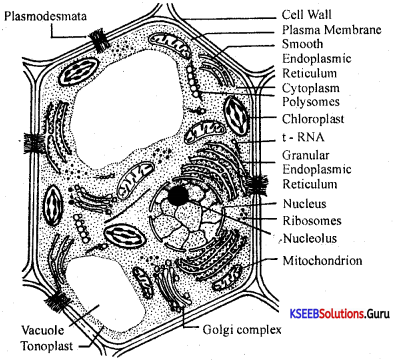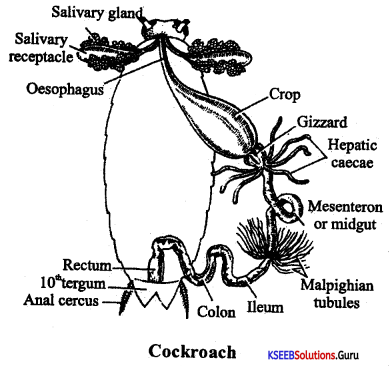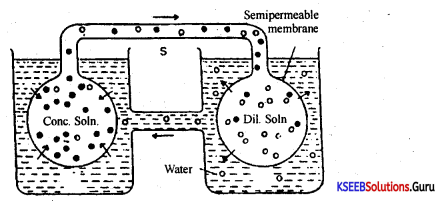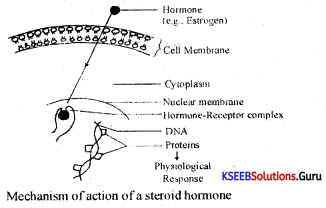Students can Download 1st PUC Biology Previous Year Question Paper March 2020 (North), Karnataka 1st PUC Biology Model Question Papers with Answers helps you to revise the complete Karnataka State Board Syllabus and score more marks in your examinations.
Karnataka 1st PUC Biology Previous Year Question Paper March 2020 (North)
Time: 3.15 Hours
Max Marks: 70
General Instructions:
- The question paper consists of four parts A, B, C, and D.
- All the parts are compulsory.
- Draw diagrams wherever necessary. Unlabelled diagrams or illustrations do not attract any marks.
Part – A
Answer the following questions in one word / one sentence each: ( 10 × 1 = 10 )
Question 1.
Define species.
Answer:
Species is the lowest level of organization and organisms belonging to a particular species have similar morphological, anatomical & physiological characters and can interbreed to produce fertile offsprings.
Question 2.
What is a parthenocarpic fruit?
Answer:
Seedless fruit.
Question 3.
Name the living mechanical tissue in plants.
Answer:
Collenchyma.
Question 4.
Name the Plastids which store proteins.
Answer:
Aleuroplast.
Question 5.
What are bio-macromolecules?
Answer:
Biomolecules whose molecular weight is less than a thousand Daltons are referred to as macromolecules while those with a molecular weight of more than a thousand, Daltons are called biomacmmokcùles.
Micromolecules include one
- amino acids
- sugars
- nucleotides and
- lipids
Biomacromolecules include
- polysaccharides
- nucleic acids and
- proteins.
![]()
Question 6.
Define plasmolysis.
Answer:
Plasmolysis is the phenomenon of cell shrinkage when the cell is placed in a hypertonic solution.
Question 7.
Name the oxygen scavenger present inside the root nodules of Leguminous plants.
Answer:
Leghaemoglobin
Question 8.
Define tidal volume.
Answer:
Question 9.
Name the red coloured, iron continuing complex protein present in RBC’s.
Answer:
Haemoglobin.
Question 10.
Mention the hormone secreted by the pineal gland.
Answer:
Melatonin.
PART-B
Answer any FIVE of the following questions in 3-5 sentences each, wherever applicable. (5 × 2 = 10)
Question 11.
Write any two-living characteristics of viruses.
Answer:
Living characters:
(a) Like organisms they contain protein and nucleic acid.
(b) Like organisms they undergo mutation.
Non – living characters:
- They are non-cellular.
- They do not show metabolism.
![]()
Question 12.
Assign the following animals to their respective phyla.
(a) Jellyfish
(b) Starfish
Answer:
(a) Colecnterate
(b) Echinodermata.
Question 13.
Distinguish between tendons and ligaments.
Answer:
1. Tendons: They are exclusively composed of white collagenous fibres arranged in regular bundles. In between these fibres, a few fibroblasts may occur. Usually, they connect muscle to bone.
2. Ligaments: They may contain both white and yellow fibres and these fibres are arranged in a less orderly patterns. Usually, they connect bone to bone.
Question 14.
Write any two functions of the Endoplasmic Reticulum.
Answer:
1. Smooth Endoplasmic Reticulum:
- Without ribosomal particles.
- Present mainly near the cell membrane.
- Mainly consists of tubules.
- Formed from rough ER by the loss of ribosomes.
2. Rough ER (Granular ER):
- Ribosomes are present on the surface of the ER.
- Mainly present near the nucleus.
- Consists of cisternae.
- Formed from nuclear membrane.
Question 15.
Mention any two physiological effects of Gibberellins.
Answer:
(a) Gibberellins are helpful in the elongation of internodes in genetically dwarf plants.
(b) Gibberellins are used to break down the dormancy of seeds and buds.
Question 16.
Briefly explain the transportation of O2 by the blood during respiration.
Answer:
Haemoglobin is called an oxygen carrier because about 97% of the oxygen is transported by RBCs. RBCs contain haemoglobin. Haemoglobin has an affinity towards oxygen. Hence haemoglobin binds with oxygen molecules to form oxyhaemoglobin.
![]()
Oxyhaeinoglobm is a very unstable compound. Hence it dissociates into haemoglobin, and molecular oxygen, when it reaches tissues.
![]()
Question 17.
Mention any two disorders of the skeletal system.
Answer:
Osteoporosis: It is all age-dependent disorder of the bones. characterised by low bone mass, deterioration of the microarchitecture of the bone and increased fragility.
Myasthenia gravis:
It is an auto-immune disorder, affecting the neuromuscular junction leading to progressive weakening and paralysis of skeletal muscles. It is caused due to non-transmission of nerve impulses due to the non-functioning of acetylcholine.
Question 18.
Name the two contractile proteins of muscle.
Answer:
Actin and Myosin.
PART-C
Answer any FIVE of the following questions in 40 to 80 words each, wherever applicable. (5 × 3 = 15)
Question 19.
Write any three universal rules of binomial nomenclature.
Answer:
- Scientific names are, generally, written in Latin or derived from Latin, irrespective of their origin.
- The scientific names are written ¡n Italics or underlined. The first word denotes the name of the genus, and the second word denotes the species.
- The generic name starts with a capital letter, while the specific name starts with a small letter.
- The name of the author is written in an abbreviated form after the specific name e.g. Mangifera indica Linn.-indicates that this species was first described by Linnaeus.
- The name should be short, precise and easy to pronounce.
Question 20.
What is aestivation? Explain any two types.
Answer:
The mode of arrangement of sepals, petals or even tepals in a flower bud is called aestivation. The different kinds of aestivation are as follows:
- Valvate aestivation – When sepals, petals or tepals are not overlapping.
- Imbricate aestivation – When out of the total number of sepals, petals or .tepals, one is completely out, one is completely in and the rest are in and out.
Question 21.
Differentiate between heartwood and sapwood.
Answer:
| Heartwood | Sapwood |
| (a) Dark in colour | (a)Light in colour |
| (b) No conduction of water | (b) Involved in conduction of water |
| (c) Nucleic acids | (c) Peripheral layer. |
Question 22.
Name the chemical bonds present in
(a) Polysaccharides
(b) Proteins
(c) Nucleic acids
Answer:
(a) Polysaccharide: Glycosidic bond.
(b) Protein: Peptide bond.
(c) Fat: Ester bond.
Question 23.
Mention the three phases of growth in plants.
Answer:
- Cell division
- Cell elongation
- Cell differentiation
![]()
Question 24.
Explain the role of gastric juice indigestion.
Answer:
Gastric juice: Pepsin, and Renin are the proteases present in gastric juice
1. Pepsin: It is an enzyme produced in an inactive form called pepsinogen. Pepsinogen is activated by HCI. Pepsin is an endopeptidase and it breaks inner peptide bonds of the protein molecule to form proteoses, peptones, and polypeptides.
![]()
2. Renin: Renin is also secreted in an inactive form called prorenin. It is activated by HCI. Renin acts on the milk protein called casein and convert it into paracasein. Paracasein in turn combines with calcium salts and forms calcium Paracaseinate (curdy precipitate).

This process of conversion into calcium Paracaseinate is called the curdling of milk.
Question 25.
Briefly explain the mechanism of blood clotting.
Answer:
It is a clot formed of threads called fibrous where dead blood and damages formed elements are trapped.
(1) Prothrombin→ Thrombokinase Thrombin ______________
![]()
Question 26.
Classify the animals on the basis of excretory material and give one example for each.
Answer:
Ammonoteilic Ex: Fish;
Ureotelic Ex: Human
Uricotelic Ex: Birds.
PART-D (Section-I)
I. Answer any FOUR of the following questions in 200-250 words each, wherever applicable. (4 × 5 = 20)
Question 27.
Mention any five general characters of Bryophytes.
Answer:
- They are non-vascular plants, exhibiting amphibious habitats.
- The gametophytic phase of the life cycle is represented by a multicellular, haploid thallus, which is called gametophyte.
- Gametophytic plant body bearing male and female sex organs, represents the dominant phase of life cycle unlike in higher plants.
- The gametophyte is autotrophic and independent in nature.
- The gametophyte produces sex organs, the antheridia and the archegonia which are multicellular.
Antheridia may be embedded within the thallus or may be specifically located at the tips of the gametophyte. It produces biciliate curved antherozoids.
Archegonia is a flask like structure. It bears a basal bulbous vendor and a narrow, hallow structure at it is summit called the neck. Within the ventçr, the female gamete or egg is situated along with a venter canal cell. The neck shows neck cells, neck canal cells and cover cells.
![]()
Question 28.
Write any four salient features of the class Aves. Mention on a flightless bird.
Answer:
- Presence of feathers.
- Presence of pneumatic bones: Pneumatic bones are long hollow bones with air cavities.
- Forelimbs are modified into wings to help in flight.
- Hind limbs generally have scales helping them to clasp the prey in-flight or a tree branch.
- Excretion of uric acid and faeces is through a single opening, and excretion uses a very little amount of water, to reduce body weight.
- An aerodynamically built body helps in flying (by reducing friction).
Question 29.
Draw a neat labelled diagram of a plant cell.
Answer:

Plant Cell – Ultrastructure
Question 30.
Draw a neat labelled diagram of the digestive system of cockroaches.
Answer:

Question 31.
List any five differences between Mitosis and Meiosis.
Answer:
| Mitosis | Meiosis |
| 1. Occurs in Somatic cells | 1. In reproductive cells |
| 2. Equational division | 2. Reduction division |
| 3. Helps in growth and repair | 3. Formation of gametes |
| 4. two daughter cell | 4. four daughter cell |
| 5. Diploid daughter cells | 5. Haploid daughter cells |
Question 32.
Explain the Mass flow hypothesis of translocation of sugar in plants.
Answer:
According to Munch, food materials are translocated from the source (leaves) to sink (roots) enmass, through a turgor pressure gradient that occurs between leaves and roots. The mechanism of translocation can be explained as follows:
1. Sugars are formed in the mesophyll cells during photosynthesis and are loaded into the phloem sieve elements of veins. This is called vein loading.
2. The osmotic potential in the phloem becomes more negative, and as a result, water is drawn into phloem elements from xylem cells.
3. Turgor pressure increases in the sieve tubes of leaves, and at the same time the turgor. the pressure of roots becomes less. So a turgor pressures gradient occurs between mesophyll cells and root cells.
4. As a result, food molecules in solution form, are translocated from leaves to roots.
5. In the roots the food ¡s consumed, and in the fruits, it is converted into insoluble starch. So osmotic potential and turgor pressure in the roots and storage organs decreases.
6. Thus turgor pressure gradient continues between leaves, and roots and translocation of food also continue.

Munch conducted a physical experiment to demonstrate the mass flow. He took two osmometers A and B, with concentrated sugar solution in A and B filled with a dilute solution.
These are connected by a ‘U’ tube C. A B is immersed in a trough containing water. Now water enters into ‘A’, due to high osmotic pressure and this creates turgor pressure. This results in mass flow of sugar solution from A to B through ‘C’ until equilibrium is attained and maintained. He compared osmometer A to leaves, B to roots, C to phloem, and water in vessels to xylem vessels. This clearly explains the mass flow hypothesis.
Section-II
II. Answer any THREE of the following questions in 200-250 words each, wherever applicable. (3 × 5 = 15)
Question 33.
Mention any one role of the following macronutrients
(a) Nitrogen
(b) Phosphorus
(c) Potassium
(d) Calcium
(e) Magnesium
Answer:
(a) Component of proteins and Nucleic acid
(b) Component of cell membranes
(c) Opening and closing of stomata
(d) Component of the middle lamella of cell wall
(e) Component of chlorophyll.
![]()
Question 34.
Write the schematic representation of the Calvin cycle.
Answer:
It occurs in the grana of the chloroplast.
It utilises the theassimùatory powers i.e., ATP and NADPH2 produced in light reaction.

Steps:
- Phosphorylation
- Carbon dioxide fixation
- Phosphorylation and reduction.
- Regeneration and RUMP
- Glucose formation.
Note:- To complete a Calvin cycle, 18 ATPs and 12 NADPH2 molecules are required.
Question 35.
(a) List any three differences between aerobic and anaerobic respiration.
Answer:
| Aerobic C.R | Anaerobic C.R |
| 1. Occurs in the presence of molecular oxygen. | 1. Occurs in the absence of oxygen. |
| 2. Centered in the cytoplasm. | 2. Centered in mitochondria and cytoplasm |
| 3. Glucose is incompletely oxidised into C2H50H and CO2. | 3. Glucose is completely oxidised into CO2 and H2O. |
| 4. Generates 38 ATPs per glucose. | 4. Generates only 2 ATPs per glucose. |
| 5. Occurs in a great majority of organisms called anaerobes. | 5. Occurs in only a few organisms called aerobes. |
(b) Define RQ. Write the RQ values of fats.
Answer:
The respiratory quotient can be defined as the ratio of the volume of CO2 released, to 0 consumed to break one molecule of respiratory substrate completely.
RQ = \(\frac{\text { Volume of } \mathrm{CO}_{2} \text { released }}{\text { Volume of } \mathrm{O}_{2} \text { consumed }}\)
RQ of carbohydrate is 1.
RQ of proteins is 0.7
RQ of fats ¡s 0.71
RQ of organic acid is more than 1(1.2 or 1.3).
Question 36.
Write the schematic representation of hormonal action.
Answer:
Mechanism of hormone action:
Hormones exert their effects on target cells by interacting with specific receptors of these cells. These receptors are proteins or lipoproteins. The location of the hormone receptor depends on the chemical nature of the hormone. The water-soluble hormones (polypeptides, glycoproteins and catecholamines) cannot pass through the plasma membrane, hence their receptors are located on the outer surface of the membrane.
Water-soluble hormone action:
The lipophilic hormones (steroids and thyroxine) can pass through the plasma membrane and enter into their target cells, hence the receptors for these hormones are located within the nucleus and cytoplasm.
The water-soluble hormones have their action mediated through second messengers. When these hormones bind to their specific receptors of the plasma membrane specific membrane proteins become activated to generate second messengers
Cyclic AMP, phospholipase C, inositol triphosphate, diacylglycerol and Ca++ act as second messengers.
The cyclic AMP second messenger system has the following sequence of events to affect the action of hormones.
- The hormone binds to the specific membrane receptor of the target cell.
- G proteins linked to specific receptors activate the enzyme adenylate cyclase.
- Activated adenylate cyclase, converts ATP to cyclic AMP.
- Cyclic AMP activates protein kinase enzymes of the cytoplasm.
- Protein Kinase phosphorylates (adding phosphate groups too) the other enzymes of the cytoplasm.
- The phosphorylation of specific enzymes may enhance or inhibit their activity.
- This alters the metabolism of the target cell in the required direction as per the specific hormone action.
Lipophilic hormone action:

The lipophilic steroid hormones and thyroid hormones pass through the plasma membrane and get bound to a specific intracellular receptor. These receptors are commonly located within the nucleus. Once these nuclear hormone receptors are activated by their binding to the specific hormones, they alter the gene expression. They may switch on or off specific genes on the nuclear DNA. The transcription of DNA occurs and the newly formed mRNA directs the synthesis of specific enzyme proteins. These enzymes alter the metabolism of the cell in the required direction as per the intended action of the hormone.
![]()
Question 37.
Name any five hormones for the pituitary gland and mention and one function of each.
Answer:
1. The pituitary gland weighs about 0.5 gm and is a pea-sized endocrine gland that lies on the ventral surface of the brain attached to the hypothalamus by a nervous stalk called the infundibulum.
2. It is called the master gland or conductor of the endocrine orchestra as several of its hormones control other endocrine glands directly. The hormones of the pituitary that influence other endocrine glands are called tropins or trophic hormones. However, the pituitary gland itself works under the influence of the hypothalamus through releasing factors. The pituitary gland is called the master gland because it controls the functions of other endocrine glands by secreting hormones.
3. Based on origin, it is divided into two parts namely Adenohypophysis and Neurohypophysis.